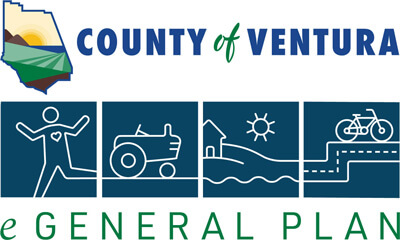Climate change is a global problem caused by the cumulative warming effects of greenhouse gas (GHG) emissions. Governments at all levels, non-governmental agencies, and private citizens and businesses are now acting to mitigate GHG emissions as quickly as possible to reduce or avoid the most catastrophic effects of climate change.
This section contains policy components of the County’s approach to greenhouse gas (GHG) emissions reduction and is a key part of the County’s overall Climate Action Plan (CAP). As noted in the General Plan introduction, the County developed an integrated approach to addressing climate change in the General Plan by incorporating policies and programs that address climate change throughout the General Plan elements. These policy components are designated with the ![]() icon next to applicable CAP policies. As such, the General Plan will serve as the County’s CAP.
icon next to applicable CAP policies. As such, the General Plan will serve as the County’s CAP.
Details on the purpose of the CAP, details regarding the General Plan’s integrated climate action strategy, and a summary of results of key technical analyses used to develop the CAP strategy are contained in Appendix B. Section B.1 of this Appendix includes the components of the County’s GHG emissions reduction strategy, while Section B.2 of this Appendix documents the County’s vulnerability to climate change and climate adaptation strategy. Also refer to Environmental Impact Report (EIR) for the 2040 General Plan, specifically Appendix D of the Draft EIR and Chapters 2 and 3 and Attachment 2 of the Final EIR, for detailed information regarding the County’s GHG emissions inventory and forecasts.
Greenhouse Gas Emissions Reduction Strategy
The current inventory of GHG emissions is organized by the following seven sectors, presented in decreasing order by level of contribution. Information on the detailed activity data, assumptions, and calculations used to develop the County’s GHG inventory are included in Appendix D of the Draft EIR, and Chapters 2 and 3 and Attachment 2 of the Final EIR.
- Transportation
- Building Energy
- Solid Waste
- Stationary Sources
- Agriculture
- Water and Wastewater
- Off-Road Equipment
Climate Change Adaptation and Resilience Strategy
In accordance with the requirements of SB 379 (2015), codified in Government Code section 65302(g)(4), climate change adaptation and resilience must be addressed in the safety element of all general plans in California. Appendix B contains a section that summarizes the County’s vulnerability assessment and a list of all CAP policies within the General Plan in Section B.3. Chapter 12, “Climate Change,” of the General Plan Background Report, released in January of 2018, summarizes the County’s vulnerabilities to the effects of climate change over the coming century. The key findings of Chapter 12 of the General Plan Background Report include:
- a rise of three to six degrees Fahrenheit (°F) by 2090 in the County;
- coastal erosion of up to 1.36 meters (4.46 feet) by 2100 due to sea-level rise;
- more frequent flooding events and more extensive and longer duration of flooding;
- elevated groundwater levels and salinity intrusion due to sea-level rise;
- the exposure of approximately 23,300 people countywide to inundation from a 100-year flood event combined with a 1.4-meter (4.6-foot) rise in sea level, many of whom are low income or especially vulnerable;
- the exposure of approximately 170 miles of roads and railways, hospitals, schools, emergency facilities, wastewater treatment plants, three power plants, and a naval base from a 100-year flood event combined with a 1.4-meter (4.6-foot) rise in sea level;
- habitat fragmentation due to changes in precipitation, increased temperatures, and rising sea levels;
- an increase of up to 79 extreme heat days per year by 2099; and
- a 15 percent increase countywide in the potential amount of area burned by wildfire between 2020 and 2085 as compared to historical trends.
This background information is further summarized in Appendix B. Specific policies and implementation programs contained in the General Plan elements that address climate vulnerability and adaptation are identified in Sections B.1 and B.3.
